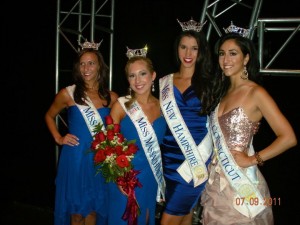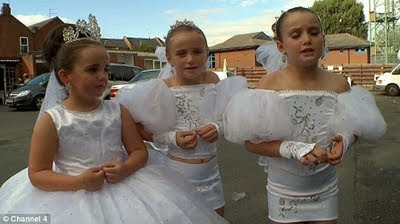Wednesdays at 10 pm are really must-see-TV for me. Thanks to my DVR I can watch TLC's tried and true Toddlers & Tiaras and Lifetime's newcomer, Dance Moms. I've long said that in many ways competitive dance and child beauty pageants have a lot in common. Imagine if JonBenét had been a competitive dancer and not a child beauty pageant queen... Well, it seems competitive dance is now getting its place in the crazy sun.

Dance Moms features the Pittsburgh- area students of dance teacher Abby Lee Miller. Miller is a character straight out of central casting. Imagine Mama Rose times a thousand (but they aren't even her kids). But she gets results, with her students winning nationwide, appearing on dance television shows, and dancing professionally. It's not that all of her rules are wrong, but it's the way she sometimes says it to her young students. Miller commented several times throughout the episode that she wants to treat her girls like professionals. Only problem is, they aren't professionals yet-- they are developing dancers and people.
Having studied competitive dance, there are several elements of the shocking show that strongly resonated with my research (oh, and several elements that don't, which I'll get to).
- It didn't surprise me at all that one of the moms featured on the show is a former Abby Lee Miller student. Not only have many dance moms done dance themselves, but some I met send their children to the same studio. This usually means they had a great experience-- though in this case it may be some form of Stockholm Syndrome?
- Other moms are definitely more critical of dance teachers. At the end of the competition featured in the premiere Miller took a mother to task over a costume mishap. The mom's rejoinder? That Miller works for her since she pays her to teach her daughter dance. Sadly, this is a pretty common refrain not just in dance but across children's competitive activities. And Miller's response was also typical-- this is my business, my livelihood, not an afterschool activity. Both are right, of course. But because afterschool teachers and coaches aren't regulated and credentialed as regular teachers are, they are often seen as careworkers by parents.
- At the regional competition several of the girls commented that having their dance teacher with them backstage right before they competed made them more nervous, since she kept giving them corrections. When I interviewed competitive dance girls-- and other competitive kids-- they expressed similar sentiments. In fact, kids love being around their peers at these events, without their teachers or parents present. Making friends and building relationships is one of their effective coping strategies for dealing with the stress of competition. As long as there is some adult supervision backstage (an outside party provided by the competition itself), I think this is the best way to help kids learn to cope with competition themselves.
- One of the things shown in this episode that shocked viewers the most, based on what I've read on message boards, was Miller's use of "the pyramid." Each week she has one girl at the top, two in the middle, and three at the bottom. I agree that this is particularly extreme and public, but, honestly, this happens all the time in these competitive kids' activities. Kids who do sports and dance are constantly competing-- not just at organized competitions. They are competing at every practice/rehearsal to see who will be the starter, who will be featured, etc. Miller makes this process more grossly transparent, but clearly it happens and kids and their parents know it. I'm not advocating for "the pyramid" approach, but it's unwise to think it's not a part of participating in any competitive activity. It's also important to note that not only are kids under constant surveillance by a teacher/coach, but they are also often literally under surveillance by their parents. In Miller's studio there is a "dance jail" where the moms can sit and watch down over the class through a glass mirror. This also famously occurs at many ice skating rinks and gymnastics gyms (if you're interested in these areas, Joan Ryan's Little Girls in Pretty Boxes remains a must read). Not all dance studios do this-- in fact, I think the best ones don't-- but the sociologist in me can't help but think of a panopticon when I watch the moms watching the dance teacher watch their girls.
So, yes, I was prety surprised by the outright naming of the competitive pyramid even if I understood it's motivations. And that wasn't all I was surprised by in this first episode!
First, it seems absurd to me that a new routine is necessary for every regional competition. This clearly has to be a reality show-inspired practice to keep up maximum drama (Will they pick up the choreography? Will the rhinestones get on the new costumes in time? Who will be featured? Etc.). I can see a small argument that learning new routines quickly is a professional dance skill-- but given that a six-year-old is one of the featured dancers on the show, it seems a touch premature.
Second, and probably most disturbing, was the moms decamping to the bar and getting tipsy during the competition. Now, look, I'm sure as a mom I will indulge in a glass of wine when necessary. I'm not a teetotaler. But, but, but, it was the two girls of the tipsy moms who had mishaps during the competition. One poor girl got burned or her arm by a curling iron (and it looked pretty painful) at the hands of her mother. The other had the aforementioned costume mishap with a hairband (which a few extra bobby pins would have prevented). I really do hate to be judgmental, but these are safety issues. Also, while some of the competitive parents I met would be happy, and free, to enjoy some alcohol after a competition is over, I know no one who would leave to consume alcohol in the middle of a competitive event.
In ay event, I can't wait to see what Dance Moms continues to bring after this insane first episode (Oh, I did mention cops coming to the studio over an angry mom, didn't I?!). Toddlers & Tiaras continues to entertain, but it has some serious competition.
Speaking of, two quick T&T observations from the past two episodes:
- As the mom-to-be of a little boy, I admit to having a serious crush on last week's featured pageant "diva", Brock, and his family. I hope whoever my son is, he is as well-adjusted as the adorable Brock. Check him out.
- Serious child beauty pageant watchers/aficionados: Did you catch Hannah Douglas, former child beauty queen, winning the $10,000 cash at Universal Royalty? Hannah was the original Eden Wood-- long before Eden was born. During the late 90s and early 2000s, Hannah Douglas RULED the pageant circuit, winning a reported $40,000 one summer. At the time she was raised by two dads, who had pageant businesses (they still do-- owning pageant systems, hair and make-up services, photography, etc.), though the dads have since split. No, this is not Leslie Butler from Living Dolls-- Hannah was a bigger success than Leslie, though both were big names. I heard a rumor that 20-year-old Hannah now has her own baby pageant queen now. Given she tried for the Miss USA system, I'm guessing this was not quite planned... In any event, her out-of-retirement win raised more than a few eyebrows at the pageant. Is it any surprise she won, really?










